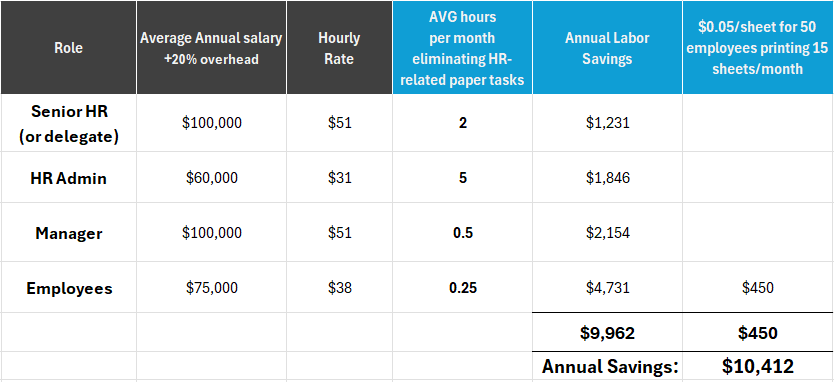How much can I save on Paperless HR with an HRMS?
HRMS Paperless HR Savings
$10,400/yr

Annual Paperless HR Savings with HR Software
HR inefficiciencies
HR Admin
HR admins save about 5 hours per month by eliminating paper-based tasks.
Wave goodbye to the endless hunt for misplaced forms, tracking down missing signatures, or sorting through mountains of paper files. With an HRMS, all employee documents, contracts, and forms are securely stored digitally—no more wasting time on manual filing.
Onboarding materials, handbooks, and performance reviews can be updated with a click, without the need to reprint and redistribute when changes are made.
HR admins also eliminate the constant back-and-forth communication with employees just to get those documents signed and returned. Everything’s streamlined, secure, and accessible when you need it.
HR Manager
HR managers save about 2 hours per month by eliminating paper-based administrative tasks that an HRMS automates. Updating employee handbooks, tracking acknowledgments, and distributing policy changes manually is time-consuming, but with an HRMS, updates are instantly published, signatures are collected digitally, and compliance is tracked automatically.
Documenting performance issues, tracking PIPs, and maintaining disciplinary records requires careful manual effort, whereas an HRMS securely stores and timestamps everything for easy access.
Managing contract and compensation adjustments often means printing, signing, and filing updates, but with an HRMS, employees sign electronically, and records are updated automatically.
Preparing for audits and generating reports can take hours when sifting through paper files, but with an HRMS, all necessary records are stored securely and available instantly.
By automating these manual processes, HR managers can reduce administrative workload, minimize errors, and focus on more strategic priorities.
Managers
Managers save about half an hour per month. No more tracking down employee reviews, performance plans, or paperwork. No more signing paper time off requests and walking them down to the Payroll office.
With digital HR systems, they can access everything in real-time, reducing the time spent handling physical documents. Managers can focus on team development and performance, rather than chasing paperwork or managing the logistics of hand-delivering documents for signatures.
Employees
Employees save about 15 minutes per month. Gone are the days of hunting through email chains or waiting for HR to dig up last year's performance review or time-off records, or deliver a printed TD1 form. With HRMS, employees can access their documents directly, update personal information, and sign off on necessary forms in real time—no more asking HR for a copy of their contract or handbook.
Other Impact
Data Security
Paper-based HR systems are a security nightmare—documents can be lost, stolen, or destroyed in a disaster. Going digital protects sensitive employee data by encrypting it and storing it in a secure, easily accessible system. HRMS ensures that employee records are safe, and the risk of losing important documents due to a fire, flood, or human error is dramatically reduced.
Scalability
As your business grows, paper-based systems become a massive burden. HRMS scales with your business, handling increasing amounts of data without requiring more space, staff, or resources. What once felt like an endless pile of paperwork now fits neatly in the cloud, ready to grow as your team does.
Environmental Footprint
Going paperless means saving around 9,000 sheets of paper each year (based on 15 sheets per employee per month for 50 employees). That’s roughly one tree saved annually, plus a reduction in waste sent to landfills. And let’s not forget the extra savings from eliminating ink cartridges and the energy consumption from printers and copiers. By embracing digital HR, your company not only slashes costs, but you also demonstrate environmental responsibility—a win for your wallet and your reputation.
